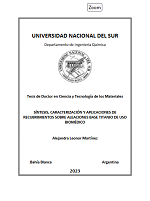Síntesis, caracterización y aplicaciones de recubrimientos sobre aleaciones base titanio de uso biomédico
Fecha
2023Autor
Martínez, Alejandra Leonor
Director
Saidman, Silvana BeatrizFlamini, Daniel Omar
Palabras clave
Ingeniería química; Corrosión; Ti-6Al-4V; Biomateriales; RecubrimientosMetadatos
Mostrar el registro completo del ítemResumen
En este trabajo de Tesis se estudiaron distintos recubrimientos
biocompatibles sintetizados sobre la aleación Ti-6Al-4V, tanto de manera química
como electroquímica, para mejorar el comportamiento frente a la corrosión en
medios fisiológicos simulados. Las películas fueron caracterizadas mediante
distintas técnicas de superficie y la resistencia a la corrosión fue evaluada
empleando diferentes métodos electroquímicos.
En primer lugar, se electrosintetizó potenciostaticamente polipirrol (PPy)
con estructura microtubular sobre la aleación Ti-6Al-4V a partir de una solución
que contenía salicilato de sodio como dopante. La presencia del polímero evitó
la disolución activa de la aleación en saliva artificial modificada. En una etapa
posterior y con el fin de desarrollar un recubrimiento antibacterial y
anticorrosivo, se empleó la matriz polimérica microestructurada para la
inmovilización de especies de Zn. Tanto el recubrimiento de PPy como el de PPy
modificado con especies de Zn mostraron actividad antibacterial frente a S.
aureus y aumentaron la protección frente a la corrosión en saliva artificial
modificada.
Por otra parte, se empleó la técnica de anodizado en modo galvanostático
para sintetizar óxidos delgados en una solución de Na2MoO4. Se estableció el
efecto de diferentes parámetros como el pH, el tiempo de anodización y la
concentración del anión inhibidor sobre el comportamiento anticorrosivo, para
luego ampliar el estudio a electrolitos que contenían NaH2PO4 y NH4VO3.
Independientemente de la solución utilizada, se obtuvieron óxidos compactos y
amorfos, sin poros ni grietas. La muestra anodizada en solución Na2MoO4
registró el mejor comportamiento frente a la corrosión en solución Ringer.
Asimismo, se sometió a la aleación Ti-6Al-4V a un tratamiento químico
con peróxido de hidrógeno. El recubrimiento resultante, constituido mayormente
por TiO2 amorfo, presentó una estructura del tipo barro agrietado. El tratamiento
redujo la cantidad de iones liberados desde la aleación al entorno fisiológico
simulado tras los ensayos electroquímicos. La técnica, sin necesidad de un
postratamiento térmico, mejoró el comportamiento frente a la corrosión de la
aleación Ti-6Al-4V en solución Ringer.
Por último, la aleación modificada mediante oxidación química en H2O2 se
empleó como sustrato para la electrosíntesis de ZnO. Las condiciones empleadas
en la síntesis dieron lugar a la formación de micro y nanoláminas de ZnO con
capacidad bactericida frente a las bacterias S. aureus y S. mutans. Si bien la
electrosíntesis de ZnO no brindó al sustrato propiedades anticorrosivas
significativas, la combinación del tratamiento de oxidación química en H2O2 con
la presencia del ZnO, permitió mejorar la protección con respecto a la del sustrato
desnudo. In this Thesis work, different biocompatible coatings chemically and
electrochemically synthesized onto Ti-6Al-4V alloy were studied to improve the
corrosion behavior in simulated physiological environments. The coatings were
characterized using different surface techniques and the corrosion resistance was
evaluated using different electrochemical methods.
Firstly, microstructured polypyrrole (PPy) films were potentiostatically
synthesized onto Ti-6Al-4 V alloy from an aqueous solution containing sodium
salicylate as a dopant. The presence of PPy prevented the active dissolution
process of the alloy in modified artificial saliva. In order to develop a coating that
prevents corrosion and microbial growth on the alloy, the microstructured
polymer matrix was later employed to immobilize Zn species. Both PPy and PPy
films modified with Zn species showed antibacterial activity against S. aureus and
increased the corrosion protection in modified artificial saliva.
On the other hand, the anodization technique was employed under
galvanostatic mode to synthesize thin oxide films from a Na2MoO4 solution. The
effect of different parameters such as pH, anodization time and the inhibitor
anion concentration on the corrosion behavior was established and the study was
then extended to electrolytes containing NaH2PO4 and NH4VO3. Compact and
amorphous oxides without pores or cracks were obtained regardless of the
solution used. The sample anodized in Na2MoO4 solution showed the best
corrosion behavior in Ringer solution.
Furthermore, the Ti-6Al-4V alloy was subjected to chemical treatment
with hydrogen peroxide. The resulting coating consisted mostly of an
amorphous TiO2 oxide with a mud-cracked structure type. The treatment
reduced the number of ions released from the alloy to the simulated
physiological environment after the electrochemical tests. The technique, without
the need for thermal post-treatment, was enough to enhance the corrosion
behavior of Ti-6Al-4V alloy in Ringer solution.
Finally, the alloy modified by chemical oxidation in H2O2 was used as a
substrate for the electrosynthesis of ZnO. The conditions employed in the
synthesis resulted in the formation of ZnO micro and nanosheets with
bactericidal capacity against S. aureus and S. mutans bacteria. Although the
electrosynthesis of ZnO did not confer significant anticorrosive properties to the
substrate, the combination of the chemical oxidation treatment in H2O2 with the
presence of ZnO improved the protection compared to that of the bare substrate
Colecciones
- Tesis de postgrado [1471]


